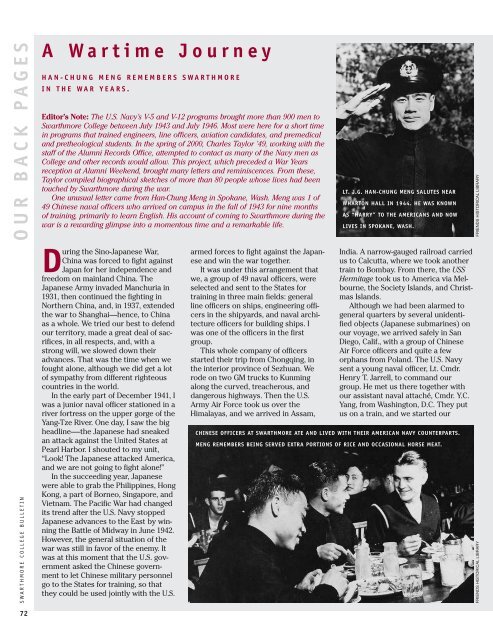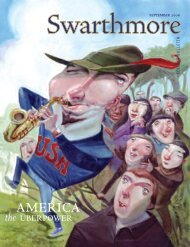L e t t e r scontinued from page 3methods such as nicotine patches andgum. Echols estimates that 10 to 15 percentof students smoke and that abouthalf of those who try to quit are successful.ANOTHER TALE OFDAYS GONE BYI was interested to read the article “AMelody From Days Gone By” in theJune Bulletin about the shipboardband who played their way to Europeon the Europa in 1937. For severalyears, I was manager of the CollegeGlee Club, and I remember DrewYoung ’37 very well from the dayswhen he was its director.In the summer of 1939, I, too, was amember of a shipboard band on a luxuryliner, the French ship Normandie,bound for Europe. John Crowley ’41had organized a shipboard band ayear earlier, and this was his secondtime around. We had John on trombone,the late Jack Myers ’40 on sax,the late Stewart Thorn ’39 on piano,and I played drums. There was a trumpetplayer too, but he wasn’t at theCollege.As with the band in the article, weplayed primarily for second-class passengers,but every now and again, wewould go up to first class or down tothird. They served only wine with allmeals, including breakfast. I’d neverdrunk wine in my life, and I had to askthe waiters to bring me water.On the way over to Europe, we raninto a severe storm with very heavyseas. The Normandie was 1,000 feetlong but very narrow relative to herlength, so she rolled violently in theswell. My drums were rolling acrossthe floor; the piano slid away; and alot of passengers got sick, including allthe band members (except for me).When we docked in Le Havre, weheaded straight for Paris. It was fascinating.The Europeans were preparingfor war. In France, they were puttingup sandbag barriers in the streets andremoving all the stained glass from thechurch windows in anticipation of thefiring and bombing.It was the summer of 1939. In Septemberof that year, Hitler invadedPoland. I figure, they got us out just intime. As it turned out, our voyage wasthe last but one that the Normandiewould make as a passenger liner. Shewas converted into a troop ship, andone year later, she burned and sank ather pier in New York.Since those days, I’ve been and amstill active as a physician, among otherthings, and I’ve made several morerecent trips to Europe, including toGermany, as drummer and band physicianfor the Hobo Band of Pitman, N.J.Reading the Bulletin article broughtthe memories flooding back, and I’dlove to know what my fellow bandmembers are up to these days andwould really appreciate hearing fromthem or from others who know ofthem.JAMES KEHLER ’40Woodbury, N.J.WITH GLEEI was delighted to see Drew Young’s[’37] face smiling at me from the pagesof the June Bulletin. Naturally, I readthis article first, and because I have abrother-in-law who made several similartrips, I found it entertaining.But I looked in vain among thedetails of Drew’s years after the cruisefor the part of his career that broughtus together. When I got to Swarthmoreas a freshman in the fall of 1937, Drewwas the director of the glee club. Fortunately,I passed his audition andenjoyed his leadership for four years.Whether or not he continued in thatactivity beyond the spring of 1941, Idon’t know. But I do know he left hismark on a lot of young Swarthmoremale students over at least four years.ROBERT TAYLOR ’41Wilmington, Del.Editor’s Note: Drew Young reports that hehas fond memories of Robert Taylor.Young has continued to direct chorusesas an avocation and has been a churchorganist for many years.UNDEFEATED—AND IGNOREDWhen I received the June Bulletin, Iturned eagerly to the spring sportshighlights, only to be disappointed notto see anything about women’s rugby.I believe it is the only Swarthmoreteam in the College to be undefeatedin its regular season this year—theyeven pulled out a win over Princeton(nationally ranked No. 2) in their finalgame.I know that this is technically a clubsport, but it is a very popular one, andthe women who play on the team areevery bit as dedicated athletes as anyin the College. My daughter, EmilyWilkins ’01, has played since she was afreshman, and next year will be thecaptain and president of a team thatattracted more than 40 new playersthis year. They are a very variedgroup, involved in all aspects of Collegelife. I hate to see their achievementsignored in the alumni publication,which should be celebrating suchsuccess.LUCINDA KIDDER ’66Northfield, Mass.AUTHORS’ QUERIESProfessor Wolfgang KöhlerIf you studied psychology with ProfessorWolfgang Köhler (at Swarthmoreduring 1936–55) and would like toshare your impressions and memories,please help with my research projectabout his work and life in America.KATHARINA KLOSSUniversity of Colognec/o Bergisch-Gladbacher Straße 87651069 Cologne, Germanykeissi@gmx.deMargaret “Peggy” Burks ’67For a biography of Margaret “Peggy”Burks ’67, who died of cancer in 1995, Iwould like to hear from fellow students,friends, or faculty memberswho knew her. Any recollections couldbe of great importance to me.JAMES CAHALAN1776 Mansfield RoadGeorgetown SC 29440(843) 545-7395mansfield_plantation@prodigy.netCORRECTIONSSam Schulhofer-Wohl ’98 (“The NewSwarthmore Journalists,” June) wasfront-page designer at the BirminghamPost-Herald, not the Milwaukee JournalSentinel, as reported in a caption.Schulhofer-Wohl also did not serve aseditor of The Phoenix as a student. Hewas the paper’s publisher throughout1996.The photo of the Ingleneuk TeaHouse fire (“Back Pages,” June) wastaken by Nathan Ashby-Kuhlman ’02.WRITE TO USThe Bulletin welcomes letters concerningthe contents of the magazine orissues relating to the College. All lettersmust be signed and may be editedfor clarity and space. Address your lettersto: Editor, Swarthmore College Bulletin,500 College Avenue, SwarthmorePA 19081-1390, or send by e-mail tobulletin@swarthmore.edu.L E T T E R SS E P T E M B E R 2 0 0 071
O U R B A C K P A G E SS W A R T H M O R E C O L L E G E B U L L E T I NA W a r t i m e J o u r n e yH A N - C H U N G M E N G R E M E M B E R S S W A R T H M O R EI N T H E W A R Y E A R S .Editor’s Note: The U.S. Navy’s V-5 and V-12 programs brought more than 900 men toSwarthmore College between July 1943 and July 1946. Most were here for a short timein programs that trained engineers, line officers, aviation candidates, and premedicaland pretheological students. In the spring of 2000, Charles Taylor ’49, working with thestaff of the Alumni Records Office, attempted to contact as many of the Navy men asCollege and other records would allow. This project, which preceded a War Yearsreception at Alumni Weekend, brought many letters and reminiscences. From these,Taylor compiled biographical sketches of more than 80 people whose lives had beentouched by Swarthmore during the war.One unusual letter came from Han-Chung Meng in Spokane, Wash. Meng was 1 of49 Chinese naval officers who arrived on campus in the fall of 1943 for nine monthsof training, primarily to learn English. His account of coming to Swarthmore during thewar is a rewarding glimpse into a momentous time and a remarkable life.During the Sino-Japanese War,China was forced to fight againstJapan for her independence andfreedom on mainland China. TheJapanese Army invaded Manchuria in1931, then continued the fighting inNorthern China, and, in 1937, extendedthe war to Shanghai—hence, to Chinaas a whole. We tried our best to defendour territory, made a great deal of sacrifices,in all respects, and, with astrong will, we slowed down theiradvances. That was the time when wefought alone, although we did get a lotof sympathy from different righteouscountries in the world.In the early part of December 1941, Iwas a junior naval officer stationed in ariver fortress on the upper gorge of theYang-Tze River. One day, I saw the bigheadline—-the Japanese had sneakedan attack against the United States atPearl Harbor. I shouted to my unit,“Look! The Japanese attacked America,and we are not going to fight alone!”In the succeeding year, Japanesewere able to grab the Philippines, HongKong, a part of Borneo, Singapore, andVietnam. The Pacific War had changedits trend after the U.S. Navy stoppedJapanese advances to the East by winningthe Battle of Midway in June 1942.However, the general situation of thewar was still in favor of the enemy. Itwas at this moment that the U.S. governmentasked the Chinese governmentto let Chinese military personnelgo to the States for training, so thatthey could be used jointly with the U.S.armed forces to fight against the Japaneseand win the war together.It was under this arrangement thatwe, a group of 49 naval officers, wereselected and sent to the States fortraining in three main fields: generalline officers on ships, engineering officersin the shipyards, and naval architectureofficers for building ships. Iwas one of the officers in the firstgroup.This whole company of officersstarted their trip from Chongqing, inthe interior province of Sezhuan. Werode on two GM trucks to Kunmingalong the curved, treacherous, anddangerous highways. Then the U.S.Army Air Force took us over theHimalayas, and we arrived in Assam,LT. J.G. HAN-CHUNG MENG SALUTES NEARWHARTON HALL IN 1944. HE WAS KNOWNAS “HARRY” TO THE AMERICANS AND NOWLIVES IN SPOKANE, WASH.India. A narrow-gauged railroad carriedus to Calcutta, where we took anothertrain to Bombay. From there, the USSHermitage took us to America via Melbourne,the Society Islands, and ChristmasIslands.Although we had been alarmed togeneral quarters by several unidentifiedobjects (Japanese submarines) onour voyage, we arrived safely in SanDiego, Calif., with a group of ChineseAir Force officers and quite a feworphans from Poland. The U.S. Navysent a young naval officer, Lt. Cmdr.Henry T. Jarrell, to command ourgroup. He met us there together withour assistant naval attaché, Cmdr. Y.C.Yang, from Washington, D.C. They putus on a train, and we started ourCHINESE OFFICERS AT <strong>SWARTHMORE</strong> ATE AND LIVED WITH THEIR AMERICAN NAVY COUNTERPARTS.MENG REMEMBERS BEING SERVED EXTRA PORTIONS OF RICE AND OCCASIONAL HORSE MEAT.FRIENDS HISTORICAL LIBRARY FRIENDS HISTORICAL LIBRARY72
















